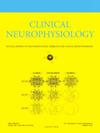A single session of motor imagery paired with spinal stimulation improves manual dexterity and increases cortical excitability after spinal cord injury
IF 3.7
3区 医学
Q1 CLINICAL NEUROLOGY
引用次数: 0
Abstract
Objective
Non-invasive stimulation of the spinal cord at the cervical level (TSCS) can induce neural plasticity and improve upper limb function in people living with cervical spinal cord injury (SCI) when paired with task practice. The aim of this study was to investigate the effects of a session of motor imagery (MI) paired with TSCS on manual dexterity, corticospinal and spinal excitability in people living with cervical SCI.
Methods
Eight participants (4 females, mean age 46yrs ± 17) completed three sessions of: 1) MI; 2) TSCS at C5–C6 level; 3) MI + TSCS, listening to the MI script while receiving TSCS. Manual dexterity was assessed with the Purdue Pegboard Test (PPT), corticospinal excitability was assessed with Transcranial Magnetic Stimulation (TMS) delivered at motor threshold and suprathreshold (120 % intensities, and spinal excitability delivered at motor threshold and suprathreshold (110 %, 120 %) intensities was assessed with single pulses of TSCS.
Results
Manual dexterity increased from baseline after all three conditions (p = 0.016). Corticospinal excitability increased from baseline after MI (p = 0.002] and MI + TSCS (p = 0.031], but not TSCS (p = 0.343). Spinal excitability was not affected by any of the conditions (p = 0.425).
Conclusions
These findings demonstrate that a single session of MI and TSCS, either alone or in combination, can increase manual dexterity in people living with cervical SCI. The increase in dexterity was paralleled by increases in corticospinal excitability for the MI and MI + TSCS conditions.
Significance
Our findings indicate that MI and TSCS improve manual dexterity and increase corticospinal excitability in people living with cervical SCI when employed in isolation or in combination.
单次运动想象配合脊髓刺激可改善脊髓损伤后的手灵巧性和增加皮质兴奋性
目的颈椎水平无创脊髓刺激(TSCS)配合任务练习可诱导神经可塑性,改善颈脊髓损伤(SCI)患者上肢功能。本研究的目的是探讨运动想象(MI)与TSCS配对对颈脊髓损伤患者手灵巧性、皮质脊髓和脊髓兴奋性的影响。方法8名参与者(4名女性,平均年龄46岁±17岁)完成3个疗程:1)心肌梗死;2) C5-C6水平的TSCS;3) MI + TSCS,在接收TSCS的同时收听MI脚本。用普渡钉板测试(PPT)评估手灵巧性,用经颅磁刺激(TMS)在运动阈值和阈上(120%)强度下评估皮质脊髓兴奋性,用单脉冲TSCS在运动阈值和阈上(110%,120%)强度下评估脊髓兴奋性。结果三种情况下的手灵巧度均较基线有所提高(p = 0.016)。心肌梗死(p = 0.002)和心肌梗死+ TSCS (p = 0.031)后皮质脊髓兴奋性较基线升高,但TSCS后无升高(p = 0.343)。脊髓兴奋性不受任何条件的影响(p = 0.425)。结论:单次MI和TSCS,无论是单独的还是联合的,都可以提高颈椎损伤患者的手灵活性。灵巧性的增加与心肌梗死和心肌梗死+ TSCS条件下皮质脊髓兴奋性的增加是平行的。意义:我们的研究结果表明,无论是单独使用还是联合使用,MI和TSCS都能改善颈脊髓损伤患者的手灵巧性,增加皮质脊髓兴奋性。
本文章由计算机程序翻译,如有差异,请以英文原文为准。
求助全文
约1分钟内获得全文
求助全文
来源期刊

Clinical Neurophysiology
医学-临床神经学
CiteScore
8.70
自引率
6.40%
发文量
932
审稿时长
59 days
期刊介绍:
As of January 1999, The journal Electroencephalography and Clinical Neurophysiology, and its two sections Electromyography and Motor Control and Evoked Potentials have amalgamated to become this journal - Clinical Neurophysiology.
Clinical Neurophysiology is the official journal of the International Federation of Clinical Neurophysiology, the Brazilian Society of Clinical Neurophysiology, the Czech Society of Clinical Neurophysiology, the Italian Clinical Neurophysiology Society and the International Society of Intraoperative Neurophysiology.The journal is dedicated to fostering research and disseminating information on all aspects of both normal and abnormal functioning of the nervous system. The key aim of the publication is to disseminate scholarly reports on the pathophysiology underlying diseases of the central and peripheral nervous system of human patients. Clinical trials that use neurophysiological measures to document change are encouraged, as are manuscripts reporting data on integrated neuroimaging of central nervous function including, but not limited to, functional MRI, MEG, EEG, PET and other neuroimaging modalities.
 求助内容:
求助内容: 应助结果提醒方式:
应助结果提醒方式:


